For every one billion particles of antimatter there were one billion and one particles of matter. And when the mutual annihilation was complete, one billionth remained - and that's our present universe. -Albert EinsteinWelcome back to our series, The Greatest Story Ever Told, where we're recounting the physical history of the Universe, from before the big bang up through the present day. We're currently in a hot, dense, expanding Universe, filled with equal parts matter and antimatter, bathed in radiation, and it's been only a tiny fraction of a microsecond for all of this to happen.
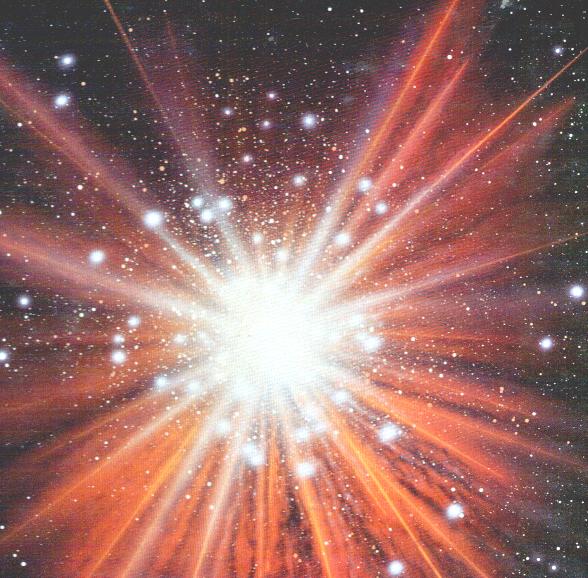
But the Universe we live in today isn't equal parts matter and antimatter. In fact, every galaxy we observe in the Universe is made out of matter and not antimatter. The laws of nature that we've discovered are pretty symmetric between matter and antimatter, and we believe that the Universe started out with equal amounts of matter and antimatter. So how are we here? If there were equal amounts and the Universe was very dense, eventually nearly all of the matter and antimatter would find their antiparticles, and would annihilate, leaving a Universe that was practically empty except for radiation (photons).
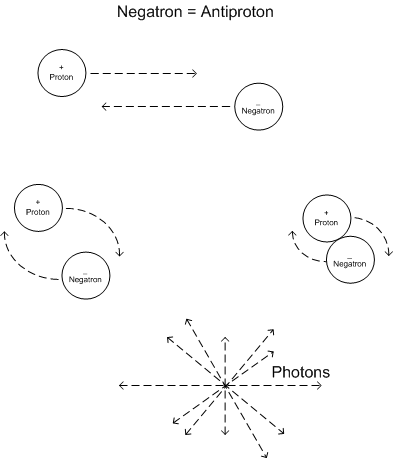
Although there are many different ways to make slightly more matter than antimatter, they all have the following properties, known as Sakharov conditions:
- You need to be able to create or destroy baryons (protons, neutrons, etc.),
- You need particles and antiparticles to have slightly different properties from one another, and
- You need to be out of thermal equilibrium.
Let me lay out the simplest scenario for you of how to make more matter than antimatter, and if you want to know the word physicists use when we talk about this process, it's called baryogenesis.
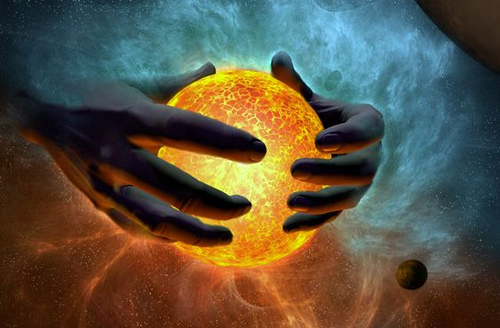
And it doesn't take anything divine, either. I'm going to assume that we have electrons (charge -1), positrons (charge +1), and that protons and neutrons are made up of quarks.
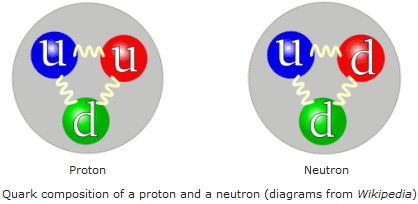
A proton has two up quarks (charge +2/3 each) and one down quark (charge -1/3), while a neutron is made up of one up quark and two down quarks, while antiprotons and antineutrons are made up of two anti-up quarks (charge -2/3) and one anti-down (charge +1/3), and antineutrons are two anti-down and one anti-up. So if we want more matter than antimatter, we need to make more quarks than antiquarks, and more electrons than positrons.
How can we get this? Imagine a particle -- I'll call it X -- that has a charge of +4/3, and can decay either into two up quarks or one positron and one anti-down quark. It also has an anti-particle -- X* -- that has a charge of -4/3, and can decay into two anti-up quarks or an electron and a down quark.
So our possibilities are:
- X --> up + up
- X --> positron + anti-down
- X* --> anti-up + anti-up
- X* --> electron + down
Is this possible? Yes; it's called CP-violation, and we've observed it in many different cases.
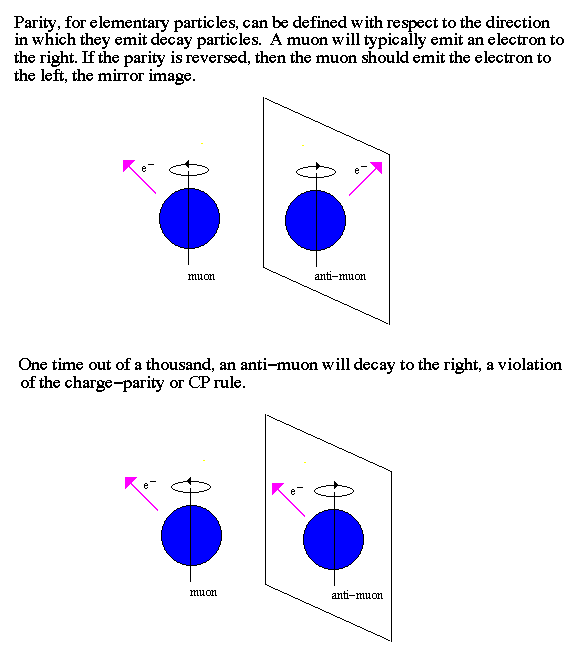
So even if everything starts out perfectly symmetric between matter and anti-matter, all you need is a slight difference between particles and anti-particles, consistent with what we observe, and you'll be guaranteed to have a Universe with either more matter than anti-matter or more anti-matter than matter!
(And if it were the other way around, you'd never know, except you'd be made of anti-matter, and you'd likely be calling it matter!)
Once you've got this problem solved -- making the matter in the Universe -- you can get on to turning it from a hot, dense, expanding soup into the Universe we see today.
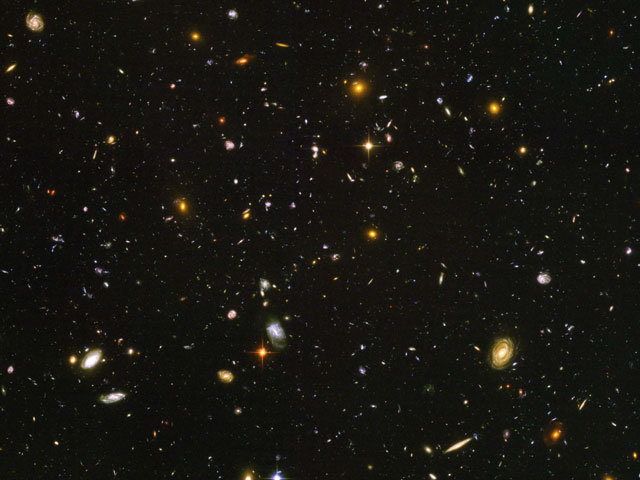
Come back for part 6, where we'll take the next step on our journey!





Comments
Not just a slight difference between particles and antiparticles, but a slight difference between particles and mirror images of antiparticles.
Equivalently, we need a slight difference between particles moving forwards and backwards in time, so the excess of matter may be connected to the arrow of time, according to CPT and all that.
Posted by: John Armstrong | March 1, 2010 8:37 PM
It is going to take some time and another reading(s?) to digest this fully for me. Before I start in with "why not the other way around too" I marked that you said "consistent with what we observe".
Posted by: NewEnglandBob | March 1, 2010 8:52 PM
| March 1, 2010 8:52 PM
Pedantry: negatron is a synonym for electron. Hence: negatron and positron are anti-particles of each other.
The most common context in which the word "negatron" is still used these days is "negatron emission", or the β- decay mode; also called electron emission. See, for example, Radioactive decay modes at the Isotopes Project, Lawrence Berkeley National Laboratory.
The antiproton is just called an antiproton.
I made the same mistake myself recently in some physics discussions, and was put right by a fellow pedant.
Posted by: sylas | March 1, 2010 11:50 PM
Is that really a quote from Einstein? He died in 1955, as I
recall, and the "steady state theory of the universe" still
seemed as viable at that time as the Big Bang. (In fact,
this was the man who devised a "cosmological constant" for
general relativity to MAKE the universe stand still. The
quote sounds like something from almost any orthodox 1980's
cosmologist.
Posted by: mike shupp | March 2, 2010 12:11 AM
Exactly,my bags are packed for the journey.
One question tho, can you clarify what exactly you mean when you say
How close would you put this phase to time=0
I'm slightly confused , wouldn't the majority of baryogenesis take place before inflation?
In other words QCD CP symmetry violation before and during inflation and electroweak CP violation after BB?
When you write of baryogenesis are you refering to only the later process?
Posted by: Sphere Coupler | March 2, 2010 12:13 AM
Thanks, Ethan.
Since we know anti-particles exist, this helps explain why we can't find any concentrations of positron, anti-proton hydrogen atoms in the visible universe or signs of their violent interaction with their counterparts, which would release massive amounts of gamma rays. In George Gamow's time (1950s-1960s), this was still considered a possibility, but at that time the best telescope was the 200 inch Palomar, no amateur tube obviously, but in and of itself, nothing like the arsenal we have today, esp. in non-visible wavelengths.
This absence also provides indirect support for the uniformity model as shown by WMAP. If the early Universe were turbulent and non-uniform, it would be likely that at least some pockets of anti-hydrogen would survive. Since with Hubble we can see galaxies going back 10 billion years we should now see at least some catastrophic interactions between interstellar clouds of anti-hydrogen and hydrogen. These should be seen as massive gamma ray bursts as gravity draws them together.
Posted by: Douglas Watts | March 2, 2010 1:25 AM
Yelp. This will take a few re-reads.
Posted by: Toad | March 2, 2010 5:02 AM
Hmmm. I don't really get it. Unless I'm misreading something, it seems like the explanation for why there's more matter than antimatter now is that initially there wasn't but that some antiparticles had a very small preference for decaying in to matter than in to antimatter.
Isn't that just pushing the question off a step without really answering it? Is the violation of that symmetry so much less of a mystery than the production of unequal amounts of matter and antimatter in the first place would have been?
Posted by: Morgan | March 2, 2010 8:20 AM
So what your saying is that from "a tiny fraction of a microsecond" on the universe has been out of balance at a very fundamental level.
That explains a lot. Like that persistent feeling things aren't right, that things are out of balance. That has always bothered me. I figured I was screwed up. That it was all perfect before I showed up and somehow I was to blame.
Now I don't feel so bad about socks disappearing in the wash and complete morons seeming to run everything. From jump street the universe has been fundamentally out of balance. In fact if it wasn't we wouldn't exist. That things being out of balance is the natural state of existence and, as Martha says 'a good thing'.
Makes me feel a lot better.
Posted by: Art | March 2, 2010 9:08 AM
Yes, mike shupp, that is a quote from Einstein; or at least widely attributed to him. I have not found the original source.
Sure, the Steady State was more credible back then, but Einstein was not a Steady State advocate. His original idea of the cosmological constant finely balanced with density at a point of zero expansion was not the same as the steady state at all... ironically. The Steady State model and the Big Bang model were two different ways to deal with the evidence for expansion.
Einstein's initial use of the cosmological constant was because at that time he thought there was no expansion. But after Hubble's results came out, he dropped that idea, and embraced the Big Bang model.
Posted by: sylas | March 2, 2010 11:24 AM
So this is a difficult topic, and perhaps my explanation was too detailed. I've tried again, and I have more on matter vs. antimatter here:
http://scienceblogs.com/startswithabang/2010/03/more_on_matter_vs_antimatter.php
Thanks for letting me know that I could have done a better job with this one. And for some of your additional comments:
Sylas @3: the word negatron goes back a looong time, and was to "proton" (a negative proton) what positron was to electron (a positive electron).
Sphere coupler @5: it needs to happen after inflation, because the Universe needs to be cool enough so that these particles are unstable and will decay. If your Universe is too hot, then you can collide quarks and leptons and make these heavy unstable particles just as quickly as they decay. We're talking an "age of the Universe" of about 10^-25 seconds or so here.
Morgan @8: we should be able to either rule out or confirm one of the possible scenarios -- electroweak baryogenesis -- with the LHC over the next few years. But you're right, we know that it happened, but we don't know all the details of how.
and to NewEngland Bob @2, Toad @7, and everyone else who feels like I could have done a better job with this, try the new post. Thanks for letting me know about this, seriously.
Posted by: Ethan Siegel | March 2, 2010 12:54 PM
Sylas:
Thanks for the friendly comment. I have to say though, I'm
still not convinced that's Einstein. Yes, in the 19-teens,
AE conceived of the cosmological constant to ensure/allow a
static universe. After Hubble concluded the universe was
expanding, during the 1920's, AE changed his opinion, even
going so far as to describe the cosmological constant as
his "greatest mistake." BUT it's a huge leap from an
expanding universe to a Big Bang universe, and the
strongest proponents of a steady state universe -- Hoyle
and Bondi and Gold come to mind -- argued for an infintely
broad universe of infinite duration with constant creation
of matter as the universe expanded. (An electron's worth
of matter per century per cubic light year -- that amount
of creation roughly, as I recall -- nothing that would have
contradicted astronomical observations of the time.) Of
course, this line of thinking went down the tubes after the
2.7K infrared background radiation was observed and
analyzed in the late 1950's to early 1960's -- but Einstein
was dead by then.
Also, it's kind of a stylistic thing, but that quote just
doesn't SOUND like Einstein to me. It's rather matter of
fact in tone, and the man loved comments with a zinger at
the end. (e.g., "Radio is the same with the cat removed.")
Posted by: mike shupp | March 2, 2010 5:31 PM
Actually, I had a bit of a different reaction - I've heard several descriptions of this phenomena before, but this is the first one that I really "got". So thanks!
Posted by: Joel | March 2, 2010 5:59 PM
It seems to me that another possibility is that there are equal amounts of matter and antimatter but all the antimatter galaxies are on the other side of the "actual" universe which is outside of the observable universe. Is this possibility mostly ignored because it's untestable, or is it in fact something that can be ruled out or considered very unlikely?
Posted by: ChrisZ | March 4, 2010 5:09 PM